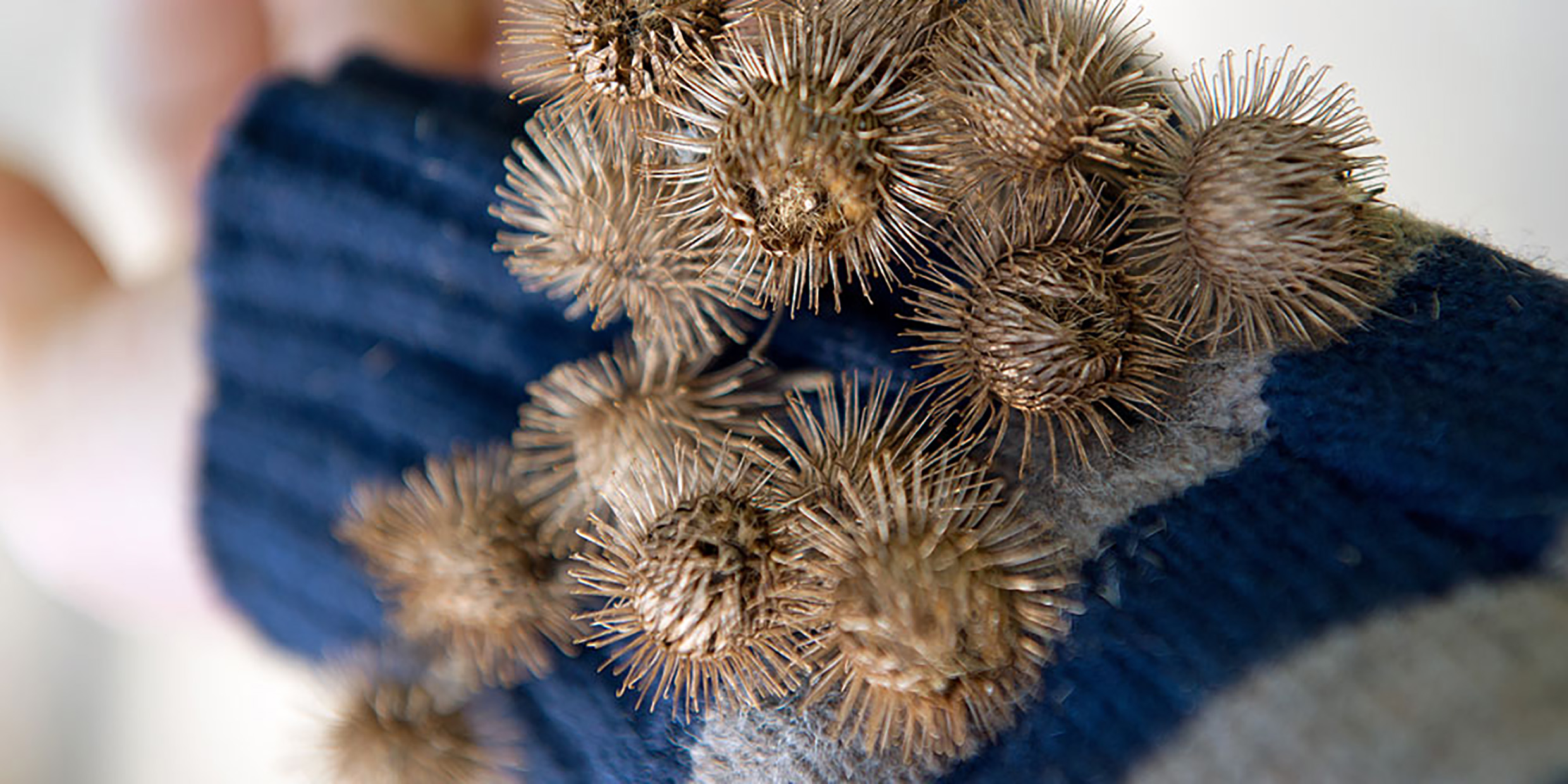Originally published 10 November 1986
This is the season of the grabbers and clingers. I came home from a walk in the woods with enough seeds stuck to my clothes to start my own weed patch. Bloom time for the wildflowers is past; now is the time when the seeds go traveling.
On the sleeves and the tail of my shirt were a dozen burrs of the burdock. Whoever invented Velcro must have been looking at this tenacious plant. The marble-sized burrs have hundreds of hooked barbs the cling stubbornly to clothing, or even to skin. In a softer season, each barb was a bract beneath the flower of the plant. Attached to each little hook is a sheath that contains a seed. Pull the burr off your clothing and the sheaths separate — and the seeds go flying.
It’s an effective strategy for getting around, and the burdock isn’t the only plant that uses it. Down around my ankles there was another hitchhiking population of seeds — the “ticks” of the beggar-ticks. A more descriptive name for the plant is sticktight. Each seed of the sticktight has a hard coat equipped with two or three tiny harpoons, thin spines with backward-directed barbs that penetrate and cling to anything that brushes against them. At this time of the year, the plant is inconspicuous, but a walk through a field can leave you pierced with more harpoons than Moby Dick.
Seeds on the move
I also collected a few seeds of the tick-trefoil, another class of pants-clingers that are harder to remove than paint. The seed pods of the tick-trefoil break easily into segments, and each segment is covered with fine hooked hairs. These little packets seem so perfectly designed to attach themselves to cloth that one wonders how the plant managed to disperse its seeds before people started wearing clothes.
The grabbers and the clingers aren’t the only seeds on the move. The milkweed, thistle, cattail and goldenrod fill the air with parachutes. I came home from my walk trailing clouds of tufted seeds behind me. And I haven’t forgotten the touch-me-not. A walk through a patch of touch-me-not is like traversing a battlefield raked by gunfire. The little spring-loaded seed pods explode when touched to hurl their contents in every direction.
Seeds on the sleeve, seeds on the wind, seeds catapulted through the air; there’s no end to the tricks these plants have contrived to spread themselves around. The lowliest weeds are prodigiously creative when it comes to dispersing themselves over the countryside.
And not just the countryside. Half of the weeds of New England made it here by crossing the Atlantic. Many of the last wildflowers of the season — Queen Anne’s lace, lady’s thumb, butter-and-eggs, catchfly, hawkweed, chickory, the common dandelion — are immigrants to our area. Some of these plants probably arrived with the Mayflower. No sooner had Miles Standish stepped down from Plymouth Rock than chickweeds, mulleins, and stinging nettles were springing up at this feet. The Indians called plaintain “Englishman’s foot” because it seemed to magically appear whereever the colonists walked.
Weeds and wildflowers
As early as 1672, John Josselyn recorded 40 kinds of weeds that had “sprung up since the English planted and kept cattle in New England.” Daisies, clover, bouncing Bet, and most buttercups came in with the cows, and although they may be one man’s weeds, they are my flowers. A weed is just a wildflower that happens to be in an inconvenient place. Half of the wildflowers in my Peterson’s Wildflower Guide are probably more appropriately called weeds, and most of them are aliens.
Out of the holds of ships, on the hides of cattle, in the seeds of crop plants, in bedding straw, in foodstuffs, snagged in the cloth of Governor Bradford’s cloak and stockings, they came, the seeds of European weeds, wafting and leaping or catching on and holding tight to find new worlds to conquer. Many plants new to this country first sprouted up alongside wharves and shipyards. From there they made their way inland along roads and canals and railroad embankments, and took up residence in any sort of disturbed soil. Native plants accustomed to quiet precolonial forests could give little competition to the aggressive intruders.
In her wonderful book, The Changing Face of New England, Betty Flanders Thomson ask this question: “What makes a weed successful, from a weed’s point of view?” And her answer is this: To make its way on open soil against the vigilant efforts of gardeners and farmers, a plant must bear seeds in abundance, have a built-in means of transportation, grow quickly and, if possible, flower and mature its seeds before it has made itself conspicuous. It is a classic design for an irresistible infiltration.
I’m not a farmer or a gardener. Sticktights and cattails are an acceptable part of my environment, and I’m glad to play my role in helping them get around. Any pilgrim plant that wants to make use of my coattails is welcome.



